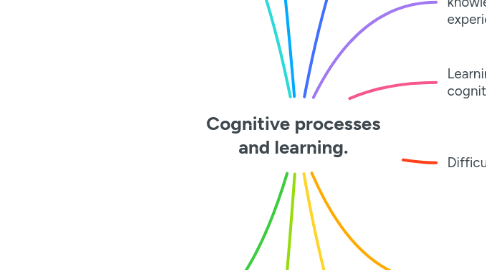
1. Cognitive processes involve developing mental representations of the events, things or ideas that can act as the basis for thought.
1.1. Develoment stages or initial learning, new area of knowledge.
1.1.1. Words
1.1.1.1. Can represent concrete and abstract categories
1.1.1.2. Can express relationships with symbolic representations.
1.1.2. Prepositions
1.1.2.1. Can make up into facts and incorporate information "believed".
1.1.3. Knowledge.
1.1.3.1. It is made up from a body. Propositions and the further relationships, also it is the basis for thinking and reasoning.
1.1.3.1.1. It enabling people to make logical inferences by a process of deriving new propositional relationships.
1.1.4. Declarative knowledge
1.1.4.1. Procedural knowledge
1.1.4.2. Information about how we can do things.
1.1.4.3. Practice become more automated.
2. Assimilation and Accommodation.
2.1. Piaget emphasized the functional quality of assimilation, where children and adults tend to apply any mental structure that is available to assimilate a new event.
2.2. Through accommodation, the person modifies his pre-existing mental schema based on the new information
3. Long-term memory, is the main way in which we store information.
3.1. Long-term memory.
3.1.1. Explicit.
3.1.1.1. Involves some degree of conscious effort.
3.1.1.2. Episodic memory.
3.1.1.2.1. Involves information about an experienced or situation.
3.1.1.3. Semantic memory.
3.1.1.3.1. Involves the recollection of ideas, nvolves the recollection of ideas, concepts and facts commonly regarded as general knowledge.
3.1.1.4. But, Semantic memory is different from episodic memory.
3.1.1.4.1. Semantic memory involves general knowledge.
3.1.1.4.2. Episodic memory involves personal life experiences.
3.1.2. Implicit.
3.1.2.1. Includes procedural memory and things learned through conditioning.
3.1.2.2. Procedural skills and actions.
3.1.2.2.1. Is responsible for knowing how to do things.
3.1.2.2.2. Involves the performance of certain cognitive and motor tasks without the conscious retrieval of past information.
3.1.2.3. Emotional conditions.
3.1.2.3.1. We learn, often without effort or awareness, to associate neutral stimuli (such as a sound or a light) with another stimulus (such as food), which creates a naturally occurring response, such as enjoyment or salivation.
4. Short-term memory.
4.1. Is subject to interruption or interference.
4.1.1. limited capacity
4.1.1.1. We can “chunk” information together we can store a lot more information in our short term memory.
4.2. Working memory.
4.2.1. Is a limited capacity store for retaining information for a brief period while performing mental operations on that information.
4.2.2. Is best thought of as the conscius part of memory that anable you to generate mental images.
5. Cognitive processes involve acquire knowledge through direct experiences.
5.1. The steps involved in cognitive processing are.
5.1.1. Attention.
5.1.2. Language.
5.1.3. Memory.
5.1.4. Perception.
5.1.5. Thought.
6. Learning involves acquiring knowledge and skills through experience, study, or being taught.
7. Learning requires cognition and cognition involves learning.
8. Difficulties.
8.1. Low levels of attainment across the board in all forms of assessment, difficulty in acquiring skills
8.1.1. Failure to register information initially.
9. Memory.
9.1. Is the storage component of learning.
9.2. The study of memory is important to education.
9.2.1. It models allow us to understand the processes of information "forgetting".
10. Schemas.
10.1. Can be thought of as structured clusters of information.
10.1.1. Represent events.
10.1.2. Concepts.
10.1.3. Actions.
10.1.4. Processes.
